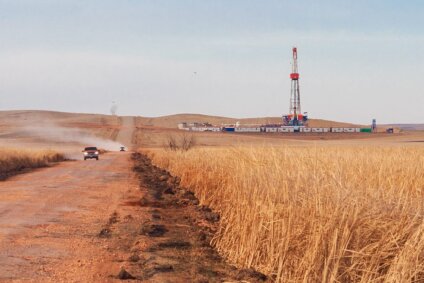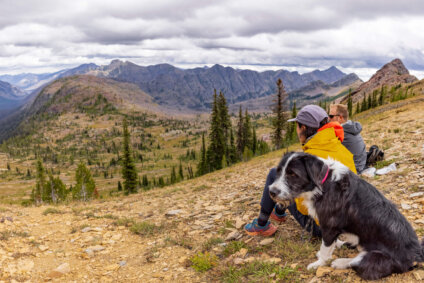What’s Life on the Trail Crew Really Like?
An inside look into life on a Volunteer Trail Crew project
As the grassy farm fields, ranches, and shimmering highway gave way to densely forested mountains and winding roads, I knew I was nearing the Continental Divide. Sure enough, I rounded a thickly vegetated curve and there it was, right in front of me. Soon, I made a right towards the Alice Creek trailhead, and the reason for my upcoming week-long volunteering adventure on the Continental Divide Trail became apparent.
In short order, the landscape surrounding the 11-mile dirt road changed from a dense green curtain to widely-spaced brown and gray toothpicks, barren trunks and skeleton branches parched red from fire damage. This was the remains of the 2017 Alice Creek Fire, and a large part of my reason for being here – to take part in the restoration of a section of the Continental Divide Trail (CDT) near Lewis and Clark Pass.
As I pulled up into the cul-de-sac at the trailhead, I saw two people sitting on the tailgate of a truck. One was wearing a cap with the CDT emblem on it, clearly visible from 50 yards away – this turned out to be Chad. Chad is the field programs manager at the Continental Divide Trail Coalition (CDTC) and was one of four volunteer crew leaders on the trip.
The other person on the tailgate was Morgan, the CDTC’s field programs coordinator, another one of the crew leaders for our hitch. We were soon joined by Haley, MWA’s summer trail steward, and Sonny, a tall and slender guy wearing sandals and a worn-down Carhartt shirt. Sonny was MWA’s stewardship coordinator, and the head honcho of our trip.
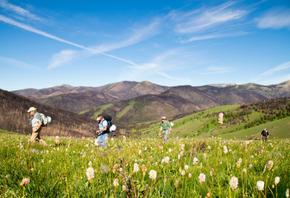
The crew treks up towards Lewis and Clark Pass (photo by Sean Jansen)
We began assembling camp and were joined in short order by other volunteers, who helped out with the effort until it came time for our first crew meeting and JHA, or Job Hazard Analysis. The ten of us lined up along two tables huddled underneath a tarp. Next to us were 100 gallons’ worth of water jugs, and a nearby creek gurgled in the background. Even now, the wind was gusting upwards of 20 miles an hour, foreshadowing of the days ahead. The moon was nearly full, and the shared joy of upcoming trail work pervaded the camp.
Our start time the next morning was at 7 a.m. That didn’t mean wake up at 7, that meant make lunch – for me, a couple of bagels with cream cheese – pull down plenty of coffee, and get a rundown on the tools and project vocabulary from Sonny. Before we knew it, we were strapped down with gear, counting down the miles on trail as we followed the footsteps of Meriwether Lewis, who crossed here on his return journey.
Reaching the pass, we took a break on the spot where we would eventually replace the historic sign marking Lewis’ crossing of the pass, burned during the Alice Creek Fire. We also took the chance to have our mandatory morning safety meeting and group stretch.
Meeting completed, the group split up for the day to tackle different projects like replacing the sign or re-treading trail that had eroded after the fire – in many places, that meant building the trail from scratch. Swinging pickaxes and pulaskis, carving away at limestone and weeds, and scraping and tamping the new trail with Rogue hoes was incredibly difficult work, but it was rewarding to see our sweat and effort carve a new trail out of the overgrown and eroded hillside.
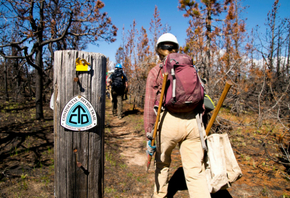
A new blaze guides the way through a section of trail that burned in the 2017 Alice Creek Fire (photo by Sean Jansen)
I should take a second to note that I have been fortunate enough to be on the other side of trail work as a trail user. In 2015, I completed a thru-hike of the Pacific Crest Trail, but not once did I take into account just how much work goes into making such an epic trail. Needless to say, this work on the CDT was teaching me the hard way what goes into building a trail.
Our day ended around 3:30, and we stowed our tools and started the hour-long hike back to camp. The four trail leaders prepared dinner – an amazing chicken curry – while the rest of us relaxed and enjoyed a little bit of downtime, hanging around the kitchen, reminiscing about the day and looking forward to tomorrow. Some of us, tea in hand, watched the sun creep behind the pass and the shadow of night extend east, eventually falling over us and turning the page to tomorrow’s agenda. A glorious full moon made headlamps unnecessary, and one by one the trail crew bedded down for the night.
No alarm was needed the next morning, as the five-in-the-morning sunrise massaged the eyes open on its own.
We woke to hot coffee and a breakfast surprise as Linda, one of the volunteers, cooked the team an egg and sausage casserole in her Dutch oven. After eating, we got ready and headed back up to the pass for our daily morning safety meeting, stretch, and task assignments.
My day’s work going to be a challenge. I made the mistake of telling Sonny that I work in landscaping, building rock patios, and he thought I’d be the perfect guy to build a water bar, a small trail dam of sorts that diverts stormwater and runoff off the trail to prevent erosion. I had to build two of them, and right away I found out that I was in a little over my head, and that building a water bar takes an incredible amount of work.
Seeing me struggling, Morgan came over to lend a hand and show me the ropes. As we were working, a bear surprised us all by running down the pass.
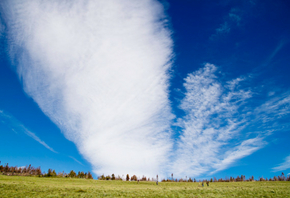
Working under the Big Sky has its advantages (photo by Sean Jansen)
Dinner that night was an epic burrito feast, which I washed down with a short walk around a foothill to capture the fire damage and wildflowers at sunset.
The next morning was beautiful, and we were joined on the hike up by two journalists from local newspapers, writing stories on the project. Morgan and I continued our water bar construction, at least until we got sidetracked and took a short hike up to Green Mountain. The views were splendid, and our work ethic dwindled as we sat up top and took in the views for longer than we needed to, strictly speaking. But eventually, we finished the water bars and huddled around the finished Lewis and Clark Pass sign for a photo to wrap up the day.
We made it back to camp just as the afternoon rainstorm broke above us.
The crew huddled beneath a tarp strung over the kitchen area, taking turns running to the fire to heat up the CDTC branding iron, which we each used to brand a cookie that had been cut from a downed tree. Carl, one of the volunteers, brought out a celebratory bottle of scotch and generously shared it around as the rain poured down.
Shortly before bedtime, the storm broke, and I wrote in my journal while a sunset like no other glowed overhead and an evening rainbow bridged the pass.
On my last day Haley and I, together with another volunteer, hiked past Green Mountain to build cairns and install blazes to help hikers follow the trail. All told, we installed 16 signs and built numerous cairns while we enjoyed the view as the rain clouds crept closer.
Once again, we wrapped up our day just in time for the rain to begin.
Back at camp, we said our goodbyes and parted ways, our stomachs full with satisfaction after our six miles of CDT trail maintenance and half-mile of complete rebuild. The feeling of accomplishment was overwhelming, and my heart is full for those who get to enjoy this beautiful section of trail. I know I will, especially know that I know how much went into building and maintaining it.
– Sean Jansen is an MWA volunteer living in Bozeman. You can find more of his work at jansenjournals.com.
Stay Connected
"(Required)" indicates required fields
